Ben Dodge (head of 10th Mountain Huts) and I spoke on the phone the the other day. As it often does, our conversation turned to how sustainable and truly “green” our existing style of mountain hut building is in Colorado — and for that matter, the rest of the world.
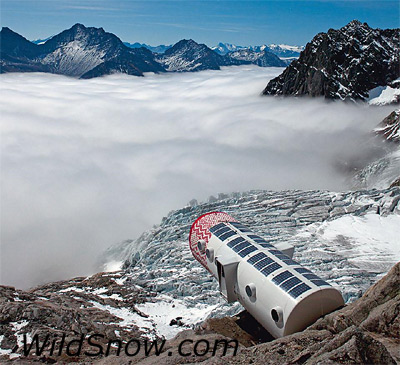
Bivacco Gervasutti, in Italian, a 'bivacco' is a small mountain hut without food service. And yes Virginia, it can be any color you want. (photo from LEAP, Living Ecological Alpine Pod collection, Francesco Mattuzzi )
We can talk all we want about how environmentally sensitive our huts are, but when we’re doing major construction projects in nearly pristine mountain environments, and depositing large edifices as a result, just what, exactly, are we “really” doing? (Hint, “depositing” might according to some environmentalists I know be the exactly correct choice in words.)
The answers are manifold, but what if we take a whole new look, for new answers? And act on our conclusions?
Italian Alpine Club answered some of the questions when they worked with architects Luca Gentilcore and Stefano Testa to create and install the amazing Bivacco Gervasutti on the Italian side of Mount Blanc. Indeed, what these guys did is get past the green talk, and take green action. They decided the old ways of heavy construction could make way to something light on the land, quickly flown in by helicopter, made from materials as green and recyclable as possible, and set on stilts so even the footprint of the structure is minimal (it’s on legs).
One has to wonder, could this sort of thing be the wave of the future? Could we Americans get past our desire for huts that are something along the lines of a replica antique petting zoo, and enjoy something modern, efficient and low-impact?
We blogged about the Bivacco Gervasutti some time ago, having been literally stunned by the concept and subsequent reality (I mean, it’s amazing they installed the thing, and it is there to be used!). But that was not to be the end of my involvement. (Extensive article in English describing the hut.)
A little while back, the Turin ski touring school of the Italian Alpine Club contacted me to give a presentation here in Italy. I was honored to be asked, but my budget wasn’t working for the trip. Bummer.
Yet around the time I was communication with the Turin folks I’d been in contact with the well known (and yes, reviled by some) developers who’d bought the controversial property in Bear Creek above Telluride, and are causing no small amount of local angst by attempting to control recreation access related to their property holdings.
From the first time I’d met these controversial guys (Ron Curry and Thomas Chapman), they’d expressed interest in installing some sort of “mountain hut” on their property in Bear Creek. I was of course skeptical, and still reserve my approval till I see results. But the idea that they’d eventually have a public amenity component to their plans (that engendered public access) is intriguing, and in my opinion worth my helping with in ways I’m comfortable with. In all, the idea is to facilitate a win/win in whatever small ways I can.
Yeah, proof is in the pudding of course, but what do I have to lose by moving past the gnashing of teeth stage and instead encouraging the developers to do something that benefits everyone’s interests, by offering my experience with mountain huts if they need advice on exactly what they could do, and why do it? In doing so, I’m true to my ideals and goals when it comes to being an advocate for recreation access. (Though as has already happened, short-sighted folks will continue to accuse me of ‘being in bed’ with the wrong folks.)
Well, as has happened, the Bear Creek guys have indeed as far as I can see become truly serious about this hut building thing. To the extent that main partner Ron Curry decided to visit the LEAP factory guys here in Turin, Italy so he could experience a personal discussion of just what’s so cool about the LEAP hut, and what it would take to actually get one over to the U.S. and install it in Bear Creek Basin! Astounding!
So, Curry told me he was working on all this and said he’d be interested in somehow getting me to join his LEAP meetings, so he’d have an American hut and recreation expert there. Ron seemed to me to be a very sincere and pleasant individual, so I told him, yeah, the Turin guys want me there anyway, so with a consulting fee for the meetings, we could make it happen. It did (I’m still reeling at how the two things came together, presentation and meeting), and not only that, it turns out LEAP architects Luca and Stefano are part of the Alpine Club ski touring scene over here. It all meshed like the batteries in your beacon case.
Now before you Telluride folks accuse me of selling out, let me assure you I have not done so. I’ve been super careful all through this process to keep my distance from the development business side, and only focus on the possibility of huts, with attention to what LEAP is doing, as well as giving Curry advice about how the sport of backcountry skiing operates in the United States and worldwide (he’s a western Colorado boy, but not a skier).
Result of all this is, again, these guys are seriously (as in spending money) looking at the mountain hut option as the “highest and best use” of their Bear Basin property. I’d agree with both adjectives in that phrase. Though just to be totally upfront with Curry and everyone else, I’d also delighted to see the property somehow made public through purchase by a land trust or otherwise.
What’s the rub? We’ll, it’ll have to work for the developers financially. But more, due to land use codes the whole concept could well be impossible — even the “public” part of the equation could be nixed by the fact that “use by right” on those types of properties includes a _private_ dwelling, but try to make it public and you’re going up against the county land use code (law of unintended consequences for the anti growth objective?).
Again, proof is in the pudding and since this is a public process, the Telluride media (and the rest of us, if we want) can watch the process progress in their county planning department. My best methods of keeping tabs are probably to stay in touch with Curry, as well as watching local media and perhaps even calling the planning department myself to see how things are going. Along with that, please loyal commenters from Telluride, chime in and let us know what you hear on the streets that’s more constructive or informational than hate.
So, let’s move on to the nuts and bolts. After all, I traveled all the way to Italy to actually talk with Luca, Stefano and Ron about this stuff.
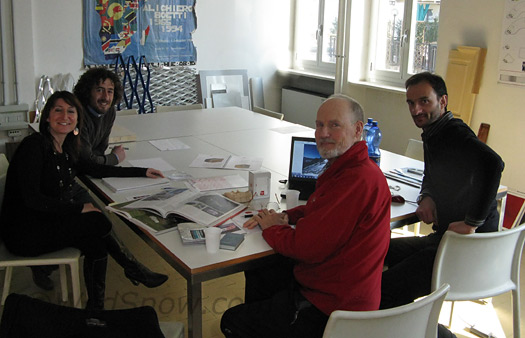
Meeting with the LEAP guys and gals. Stefano Testa to right, me, Cristiana (who graciously interpreted) and Luca.
Luca and Stefano’s “LEAP” (Living Ecological Alpine Pod) business is a subset of their work as architects. Nonetheless, the amount of media attention the new hut has received is astounding. They told me that during some days they have up to 15 journalist inquires stacked up and waiting for Cristiana to handle (she’s their PR person).
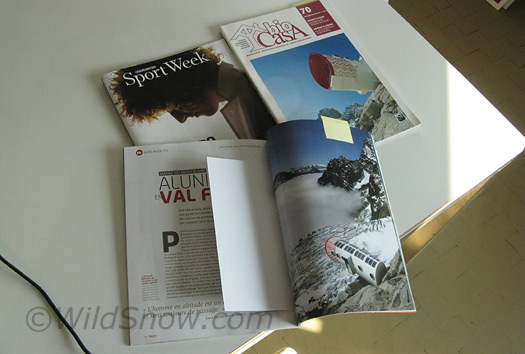
A tiny percentage of LEAP media coverage over past months.
A lot of the interest comes from the fact that newer environmental regulations in the Alps have grandfathered the older huts in many ways, but made it difficult or sometimes nearly impossible to install anything new. Remind you of somewhere else?
That’s where these guys’ concept comes in. The LEAP shelter is built like the sandwich hull of a composite boat, only the hut walls don’t have to be as strong as a boat hull, so they use lots of foam as the matrix with as much reinforcement in there as necessary to reach engineering specifications. That makes the structure super insulated, but light enough to create as sections that can be flown in by helicopter or moved by small truck. The sections fasten together with a flange and bolt system, gasketed, high-grade silicone caulk forming the final weather defense for the seam.
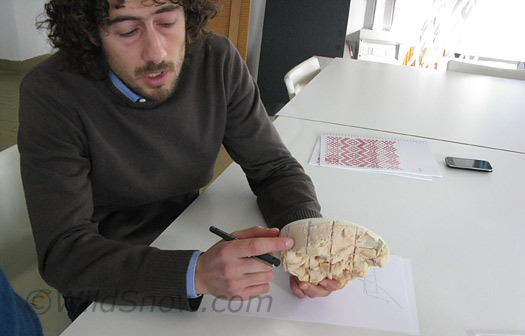
Foam core of the LEAP pod, this is an actual chunk cut out during installation of vent.
The structure can be built to quite larger sizes with enough strength for snow-load roof spans. Interestingly, Luca and Stefano told me the smaller design used for the Mt. Blanc bivvy would stay plenty warm inside from body heat (even with necessary ventilation). To prevent stove fumes, cooking is only allowed on one small electric hot plate, powered by the solar system.
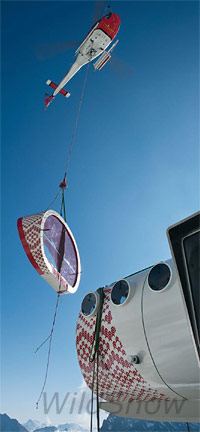
LEAP section during heli install. Each part is engineered to be within spec for chosen freight method. Francesco Mattuzzi photo.
We had a lengthy conversation about sanitation, as that seems to be the rub for many hut projects and where the regulatory agencies can really block things (no pun intended, but I’ll take it, grin). In many cases around the world, the simple solution is to use a vault toilet and have it pumped, or swapped when full. Via helicopter or truck, expensive. LEAP solution is to use existing composting toilet technology, but make it work super well by encapsulating the bathroom in a LEAP pod with carefully regulated temperature and PV power. If that’s done well, nearly 100% of human waste is taken care of on site.
As mentioned above, a big deal with this sort of thing is they’re not created by doing an impactful construction project in the mountains. Instead, they’re totally pre-fabbed by vacuum molding and detailing in a factory or other roomy and equipped facility. Material choices can be as green as one desires. Yes, it’s plastic, but you can use the most recyclable, reclaimed, green plastic you want. And really, not much of it. Is a log cabin greener? Perhaps in some ways, but considering how “green” we’re doing plastic for everything from Patagonia jackets to Toyota cars, I’m not too worried about that aspect of the LEAP shelter.
Downsides? I didn’t see much. Let me tell you, these guys are alpinists and hut users themselves, and they seem to have thought everything through.
Aesthetics are of course a sticking point. As I mentioned above, we’re used to our huts being done in a kind of replica antique motif, what with rustic wood construction, wood stoves, more. Yet that style is consumptive, expensive to build, and doesn’t lend itself to smaller venues. A LEAP pod can be installed nearly anywhere — in a day. Not only that, but it can be taken apart and moved in hours. (And I repeat, any color.)
Interior finish in these things, as done on Mt Blanc, is similar to a high-end ocean yacht. LEAP even uses marine hardware for the doors and windows. For the interior, you could easily go with wood highlights and even wood veneer paneling, to keep users with plastic paranoia from freaking out.
Will anyone in Colorado take the leap to a LEAP style hut? Who knows. Anyone from 10th Mountain Huts to the Bear Basin developers could be the first to install one (assuming it could get permitted). Consider what Luca told me: “We continue to improve how we build the dwellings in our cities, why not work equally as hard at improving our backcountry shelter systems?
If any of you guys have questions, I’ve got a lot more details rattling around in my skull, and the LEAP folks may chime in as necessary. Oh, and please don’t get me wrong, I like some of our “antique replica petting zoo” huts — just trying to make a point. Meanwhile, presentation for Alpine Club is tomorrow and after that I’ll hopefully start getting some turns under my skis. Torino is a big city and I’m out of place!
WildSnow.com publisher emeritus and founder Lou (Louis Dawson) has a 50+ years career in climbing, backcountry skiing and ski mountaineering. He was the first person in history to ski down all 54 Colorado 14,000-foot peaks, has authored numerous books about about backcountry skiing, and has skied from the summit of Denali in Alaska, North America’s highest mountain.
